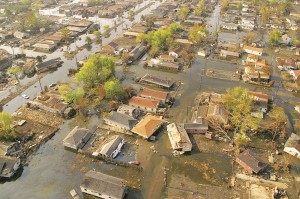Two CPRA lawsuits add to recent coastal litigation
16th December 2013 · 0 Comments
By Susan Buchanan
Contributing Writer
The blame game over who’s responsible for Louisiana’s wetlands loss and hurricane defenses and how to pay for them accelerated this month. The state’s Coastal Protection and Restoration Authority decided to sue the U.S. Army Corps, rather than participate in cost sharing in a $3 billion Mississippi River Gulf Outlet or MRGO restoration project. CPRA also doesn’t want to pay for maintenance associated with the Corps’ upgraded Algiers Canal levees. As it is, CPRA may be strained to come up with funds for its $50 billion, 50-year Coastal Master Plan, which is banking heavily on expected fines against BP for the 2010 Gulf oil spill.
CPRA’s board on Dec 3 approved two legal actions against the Army Corps. “The lawsuits pertain to interpretations of federal law,” CPRA chairman Garret Graves said last week.“ Of the eleven board members or their designees who were present at the CPRA meeting, all approved the litigation. ”In the case of the MRGO, Congress directed the Corps to construct this project at full, federal expense,” Graves said. ”CPRA will continue partnering with the Corps to advance this important project but the Corps’ effort to make the state pay a share of over $1 billion on a full, federal-expense project is out of line.”

Flooding in the Lower Ninth Ward during Hurricane Katrina was
blamed on the MRGO channel, which was closed in 2009.
Graves said the state has committed more money than the feds to revitalizing the region near the now-closed MRGO. “We’re currently working on $100 million worth of restoration projects in the MRGO area,” he said. Among its efforts, the state has built hydrological barriers near the former shipping channel.
So far, the Corps’ MRGO rehab work has centered on a study done from October 2008 to September 2012. “The MRGO Ecosystem Restoration Feasibility Study was completed last year at a cost of $15 million,” Ken Holder, public affairs chief at the Army Corps’ New Orleans District, said last week. “This was a 100 percent, federally-funded effort, which resulted in a signed Chief of Engineer’s report recommending the plan’s implementation, provided that a non-federal sponsor agrees to cost-share.”
According to the Corps, Section 103 of the Water Resources Development Act of 1986 requires that all coastal restoration projects have a non-federal, 35-percent cost-share sponsor. If a sponsor is found for the MRGO’s eco-restoration, Holder said the Corps can begin reviving over 57,000 acres of wetlands and coastal habitat at the cost of $3 billion.
The 60-mile MRGO, built as a shortcut from New Orleans to the Gulf of Mexico, was closed in 2009. The channel’s width grew beyond its original scope during the Corps’ dredging over four decades. MRGO’s existence allowed frontal waves during Katrina to attack levees that protected the Lower Ninth Ward and St. Bernard Parish. The channel is blamed for significant flooding, saltwater intrusion and wetlands loss.
In its second, planned suit, CPRA doesn’t want to shoulder the expense of the refurbished Algiers Canal levees. “A 1999 and 2007 federal law states that the operations, maintenance, repair, rehabilitation and replacement of the Algiers Canal levee area remains a federal responsibility,” Graves said last week. He was referring to the Water Resources Development Acts of 1999 and 2007. “Contrary to the law, the Corps is attempting to force these responsibilities upon the Southeast Louisiana Flood Protection Authority-West,” he said.
The SLFPA-West provides protection for the west bank of the Mississippi River in Jefferson and Orleans parishes, and is comprised of the Algiers Levee District—serving Orleans’ west bank—and the West Jefferson Levee District. The SLFPA-West’s jurisdiction covers 67 miles of levees, walls and gates to protect against hurricane flooding.
Holder said the Army Corps spends about $250,000 annually on operations and maintenance, including grass cutting, on 18 miles of levees adjacent to the Gulf Intracoastal Waterway-West/Algiers Canal. The levees are part of the detention basin for the West Closure Complex, which the Corps calls “the area’s first line of defense” against hurricanes. Under the Corps’ Algiers Canal Risk Reduction Features project, earthen levees were stabilized and raised over several years following Katrina. Levees along an area known as the Algiers Canal Industrial Reach were built to plus 8.2 feet, and berms were added on the levees’ inland side for stabilization. Work on gates and other structures along the Algiers Canal was completed last summer. When its mechanisms are shut, the GIWW-West Closure Complex is designed to block storm surge from reaching the Algiers Canal.
“A pool of funds will be needed to pay for maintenance of the Algiers Canal levees,” State Senator Jean-Paul “JP” Morrell of District 3, including Algiers, said last week. Without help from the federal government, he’s concerned about upkeep. ”Most of the money that CPRA plans to spend in South Louisiana is on coastal restoration projects, not levee maintenance,” he said.
The Army Corps has yet to hear from CPRA about the two lawsuits. “To my knowledge, at this point there is no pending legal action against the Corps by CPRA,” Holder said late last week. It would be speculative to comment on any possible litigation, he said. Preliminary legal work on the two suits has been done by the Office of the Louisiana Attorney General in conjunction with CPRA.
Despite the current dust-up, Graves said CPRA remains committed to its partnership with the Army Corps. “In these two discreet cases, our attorneys have a difference of opinion with the Corps’ lawyers,” he said last week. “Our Congressional delegation agrees that our position is consistent with the law and Congressional intent.” CPRA wishes to use the more than $1 billion sought by the feds—for what the state views as federal liabilities—differently, and instead wants to build levees and restore coastal areas, meeting the priorities of Louisiana residents, Graves said.
Graves and Governor Bobby Jindal, meanwhile, are battling the Southeast Louisiana Flood Protection Authority-East over a lawsuit filed last summer against 97 oil, gas and pipeline companies. Graves has asked the levee board to drop the suit, saying it interferes with the state’s restoration strategies. When three seats on the SLFPA-East board opened in September, Jindal appointed three new members who oppose the litigation. But on Dec. 5, the SLFPA-East board voted 5-3, affirming its decision to sue oil-and-gas operators to make them restore damaged wetlands outside the East Bank levees or pay for harm that can’t be reversed.
In other litigation, Plaquemines Parish in November filed 21 lawsuits against a number of oil-and-gas companies, and Jefferson Parish filed seven suits, all for violations of environmental regulations and failing to meet permit requirements. The St. Bernard Parish Council in early December authorized similar legal action. Officials of Terrebonne and Lafourche Parishes, however, have said they aren’t pursuing oil-and-gas operators at this time.
This article originally published in the December 16, 2013 print edition of The Louisiana Weekly newspaper.



